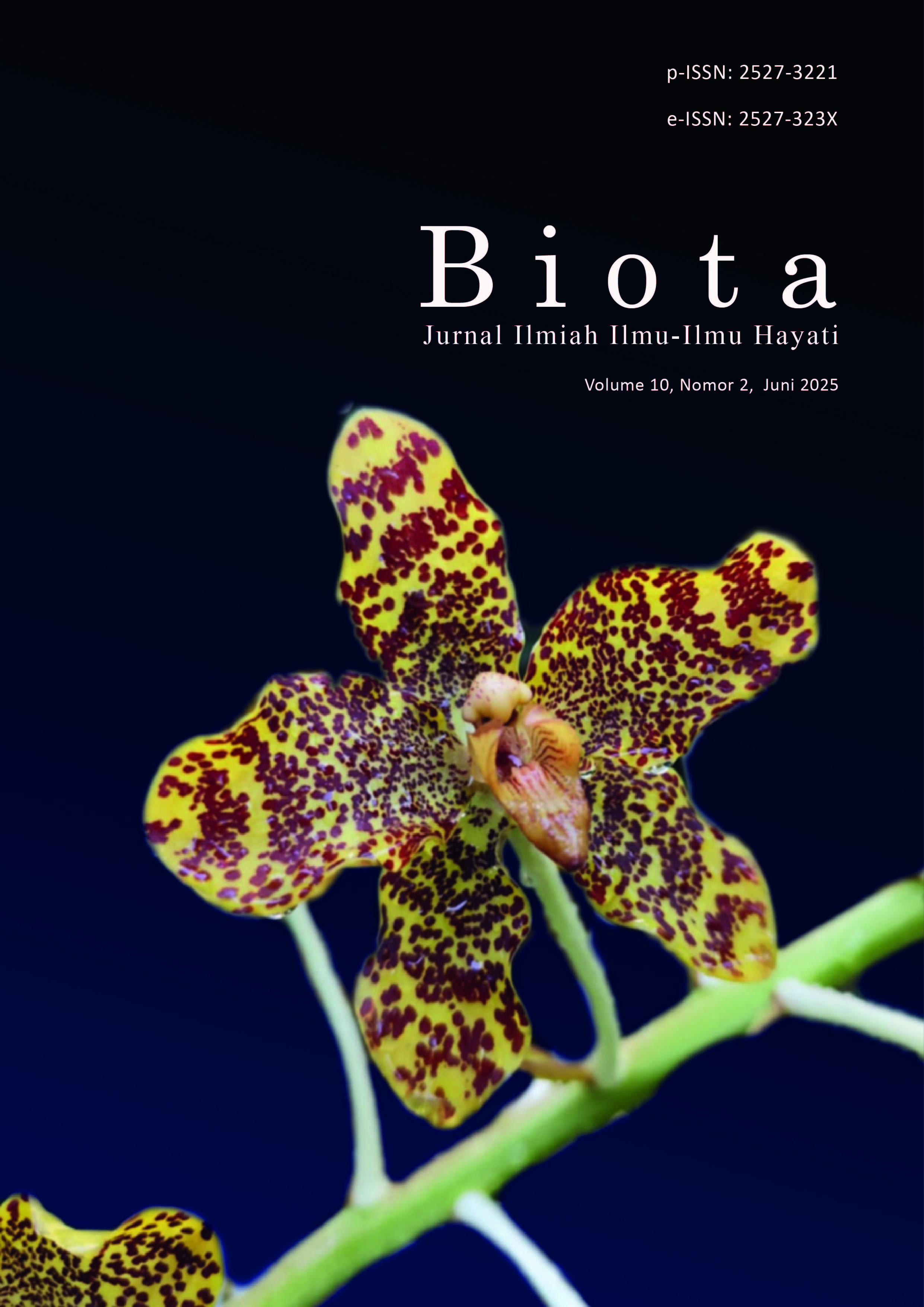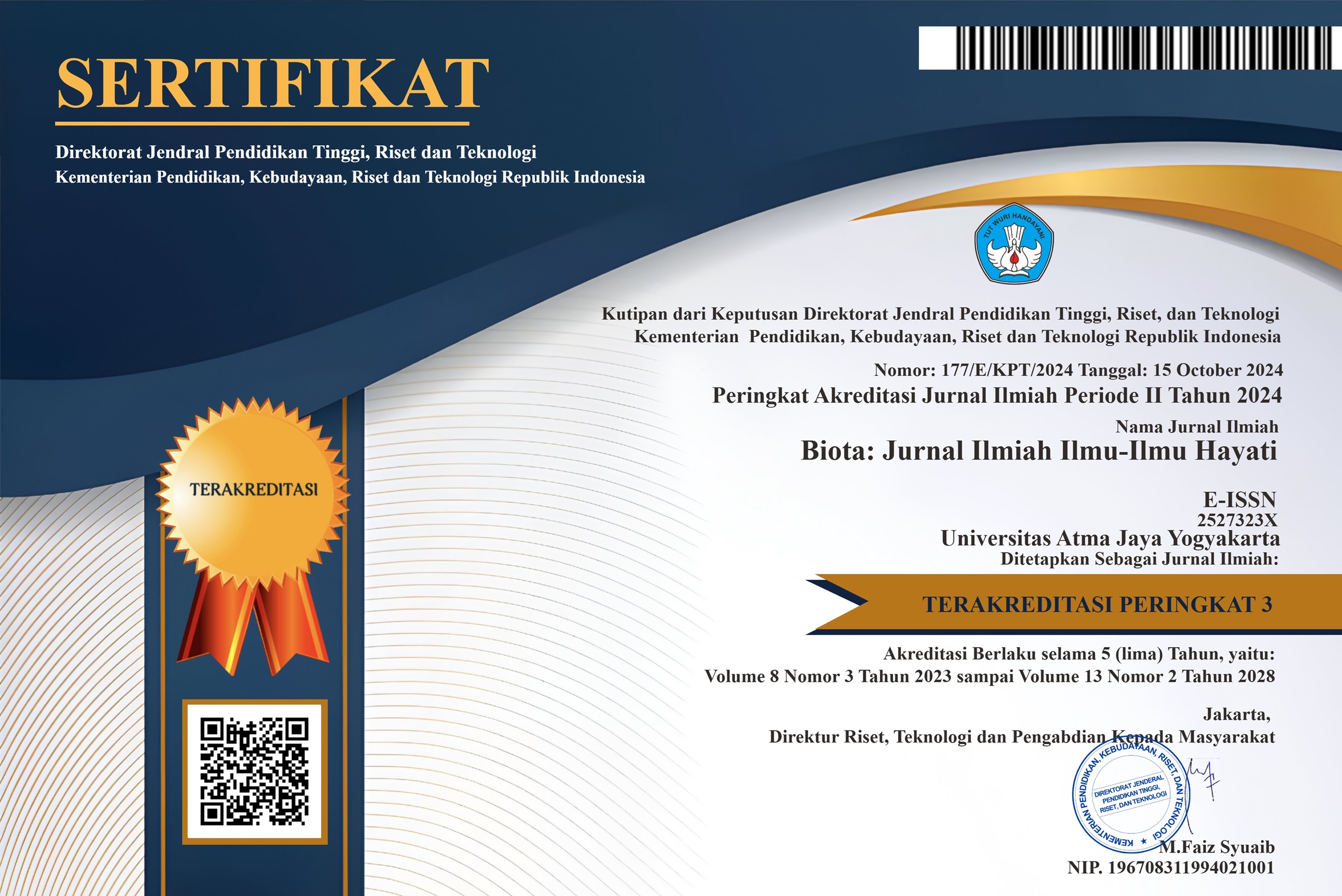Isolation and Screening of Cellulolytic Soil Bacteria from Dramaga Forest in Bogor
DOI:
https://doi.org/10.24002/biota.v10i2.11262Keywords:
Carboxyl methyl cellulose, cellulolytic bacteria, cellulose, cellulase enzyme, soilAbstract
Cellulolytic bacteria can produce cellulase enzymes, which allow them to degrade cellulose into simpler chemicals while using it as a growth substrate. These bacteria have drawn a lot of interest due to their unique properties and potential uses, such as in agriculture and the food industry. Soil is one of the habitats of cellulolytic bacteria. This study aims to determine the potential and screening of cellulolytic bacterial isolates. Cellulolytic bacteria were isolated from soil samples and cultured using selective Carboxyl Methyl Cellulose (CMC) media. Five purified isolates were collected, and their cellulase enzyme activity was qualitatively assessed using the Congo red test. Isolated bacteria code Area Jalan Setapak (AJS1) produced a higher clear zone index and will be used for further testing. Quantitative analysis of isolate AJS1 revealed its highest enzyme activity after ten minutes of incubation, with 0.0049 U/mL unit activity and 0.018 U/mg specific activity. Based on morphological and biochemical characteristics, isolated AJS1 was identified as Corynebacterium spp.
References
Abdella, M. A. A., Ahmed, N. E., & Hasanin, M. S. (2024). Green ecofriendly enhancement of cellulase productivity using agricultural wastes by Aspergillus terreus MN901491: statistical designs and detergent ability on cotton fabrics. Microbial Cell Factories, 23(1), 1–13.
Akhtar, N., & Goyal, D. (2015). Biosurfactants and Bioemulsifiers for Treatment of Industrial Wastes. Advances in Biodegradation and Bioremediation of Industrial Waste, 2015, 141–168.
Arju Hossain, Md., Akash Ahammed, Md., Islam Sobuj, S., Kubra Shifat, S., & Dipta Somadder, P. (2021). Cellulase Producing Bacteria Isolation, Screening and Media Optimization from Local Soil Sample. American Journal of Microbiological Research, 9(3), 62–74.
Bamrungpanichtavorn, T., Ungwiwatkul, S., Boontanom, P., & Chantarasiri, A. (2023). Diversity and cellulolytic activity of cellulase-producing bacteria isolated from the soils of two mangrove forests in Eastern Thailand. Biodiversitas, 24(7), 3891–3902.
Bautista-Cruz, A., Aquino-Bolaños, T., Hernández-Canseco, J., & Quiñones-Aguilar, E. E. (2024). Cellulolytic Aerobic Bacteria Isolated from Agricultural and Forest Soils: An Overview. Biology, 13(2), 1-22.
Benalaya, I., Alves, G., Lopes, J., & Silva, L. R. (2024). A Review of Natural Polysaccharides: Sources, Characteristics, Properties, Food, and Pharmaceutical Applications. International Journal of Molecular Sciences, 25(2), 1-32.
Borthakur, I., Devi, R. P., Karthikeyan, S., Ramesh, D., & Murugananthi, D. (2024). Microbial Cellulase Production: Current Technologies and Future Prospects. Journal of Pure and Applied Microbiology, 18(4), 2188–2204.
Demissie, M. S., Legesse, N. H., & Tesema, A. A. (2024). Isolation and characterization of cellulase producing bacteria from forest, cow dung, Dashen brewery and agro-industrial waste. PLoS ONE, 19(4 April), 1–12.
Ejaz, U., Sohail, M., & Ghanemi, A. (2021). Cellulases: From bioactivity to a variety of industrial applications. Biomimetics, 6(3), 1–11.
Fouda, A., Alshallash, K. S., Atta, H. M., El Gamal, M. S., Bakry, M. M., Alawam, A. S., & Salem, S. S. (2024). Synthesis, Optimization, and Characterization of Cellulase Enzyme Obtained from Thermotolerant Bacillus subtilis F3: An Insight into Cotton Fabric Polishing Activity. Journal of Microbiology and Biotechnology, 34(1), 207–223.
Fu, Z. H., Liu, J., Zhong, L. Bin, Huang, H., Zhu, P., Wang, C. X., & Bai, X. P. (2022). Screening of cellulose-degrading yeast and evaluation of its potential for degradation of coconut oil cake. Frontiers in Microbiology, 13(October), 1–14.
Fu, Z., Zhong, L., Tian, Y., Bai, X., & Liu, J. (2024). Identification of Cellulose-Degrading Bacteria and Assessment of Their Potential Value for the Production of Bioethanol from Coconut Oil Cake Waste. Microorganisms, 12(2), 1-15.
Gatpatan, I. G. T., Cabulong, R. B., & Sadaba, R. B. (2024). Diversity and Screening of Cellulolytic Microorganisms from Mangrove Forests, Natural Parks, Paddy Field, and Sugarcane Plantation in Panay Island, Philippines. International Journal of Microbiology, 2024, 1-16.
Islam, F., & Roy, N. (2018). Screening, purification and characterization of cellulase from cellulase producing bacteria in molasses. BMC Research Notes, 11(1), 1–6.
Jiang, L., Jia, G., Wang, Y., & Li, Z. (2020). Optimization of Sporulation and Germination Conditions of Functional Bacteria for Concrete Crack-Healing and Evaluation of their Repair Capacity. ACS Applied Materials and Interfaces, 12(9), 10938–10948.
Kamali, E., Jamali, A., Izanloo, A., & Ardebili, A. (2021). In vitro activities of cellulase and ceftazidime, alone and in combination against Pseudomonas aeruginosa biofilms. BMC Microbiology, 21(1), 1–10.
Kim, S. J., Hyeon, J. E., Jeon, S. D., Choi, G. wook, & Han, S. O. (2014). Bi-functional cellulases complexes displayed on the cell surface of corynebacterium glutamicum increase hydrolysis of lignocelluloses at elevated temperature. Enzyme and Microbial Technology, 66, 67–73.
Kurniawati, L., Kusdiyantini, E., & Wijanarka, W. (2021). Pengaruh Variasi Suhu Dan Waktu Inkubasi Terhadap Aktivitas Enzim Selulase Dari Bakteri Serratia marcescens. Bioma : Berkala Ilmiah Biologi, 23(1), 33–42.
Lin, K., Han, S., & Zheng, S. (2022). Application of Corynebacterium glutamicum engineering display system in three generations of biorefinery. Microbial Cell Factories, 21(1), 1–12.
Miller, G. L. (1959). Use of Dinitrosalicylic Acid Reagent for Determination of Reducing Sugar. Analytical Chemistry, 31(3), 426–428.
Monika, K., & Rukhaya, S. (2025). Enzymes at Work: Eco-Friendly Solutions for Modern Textile Finishing. Vigyan Varta An International E-Magazine for Science Enthusiats, 6(1), 178–186.
Moyes, R. B., Reynolds, J., & Breakwell, D. P. (2009). Differential staining of bacteria: Gram stain. Current Protocols in Microbiology, SUPPL. 15, 1–8.
Nababan, M., Gunam, I. B. W., & Mahaputra Wijaya, I. M. (2019). Produksi Enzim Selulase Kasar Dari Bakteri Selulolitik. Jurnal Rekayasa Dan Manajemen Agroindustri, 7(2), 190.
Paray, A. A., Singh, M., & Amin Mir, M. (2023). Gram Staining: A Brief Review. International Journal of Research and Review, 10(9), 336–341.
Porkavi, B., Kalaiselvi, P., Davamani, V., Anandham, R., & Maheswari, M. (2021). Qualitative and quantitative assessment of cellulolytic enzyme production in the microbial isolates from environmental samples. The Pharma Innovation, 10(2), 127–131.
Putri, A. L., & Setiawan, R. (2019). Isolation and screening of actinomycetes producing cellulase and xylanase from Mamasa soil, West Sulawesi. IOP Conference Series: Earth and Environmental Science, 308(1), 5–11.
Rahman SU, Ra. M. S. H. Z. N. Z. S. A. A. B. I. F. (2021). Microbial Cellulases: A Review on Strain Development, Purification, Characterization and their Industrial Applications. Journal of Bacteriology and Mycology, 8(5), 1-5.
Ranganathan, S., Mahesh, S., Suresh, S., Nagarajan, A., Z. Sen, T., & M.Yennamalli, R. (2022). Experimental and computational studies of cellulases as bioethanol enzymes. Bioengineered, 13(5), 14028–14046.
Ray, D., Anand, U., Jha, N. K., Korzeniewska, E., Bontempi, E., Proćków, J., & Dey, A. (2022). The soil bacterium, Corynebacterium glutamicum, from biosynthesis of value-added products to bioremediation: A master of many trades. Environmental Research, 213(May ), 1-12.
Sahu, T., Choudhary, R., & Kulkarni, P. (2024). Isolation and Screening of Cellulase Producing Bacteria from Sugar Industry Waste. Research Journal of Agricultural Sciences(July), 918-921.
Teather, R. M., & Wood, P. J. (1982). Use of Congo red-polysaccharide interactions in enumeration and characterization of cellulolytic bacteria from the bovine rumen. Applied and Environmental Microbiology, 43(4), 777–780.
Wang, J., Bao, F., Wei, H., & Zhang, Y. (2024). Screening of cellulose-degrading bacteria and optimization of cellulase production from Bacillus cereus A49 through response surface methodology. Scientific Reports, 14(1), 1–14.
Yunus, G., & Kuddus, M. (2021). Cold-Active Microbial Cellulase : Novel Approach To Understand Mechanism And Its Applications In Food And Beverages Industry. Journal of Microbiology, Biotechnology and Food Sciences, 10(4), 524–530.
Downloads
Published
How to Cite
Issue
Section
License
Copyright (c) 2025 Ratu Weridyaningrum, Witiyasti Imaningsih, Gusti Nur Aida Fasha

This work is licensed under a Creative Commons Attribution-NonCommercial 4.0 International License.
Authors who publish with Biota : Jurnal Ilmiah Ilmu-Ilmu Hayati agree to the following terms:
- Authors retain copyright and grant the Biota : Jurnal Ilmiah Ilmu-Ilmu Hayati right of first publication. Licensed under a Creative Commons Attribution-NonCommercial 4.0 International License that allows others to share the work with an acknowledgment of the work's authorship and initial publication in this journal.
- Authors are able to enter into separate, additional contractual arrangements for the non-exclusive distribution of the journal's published version of the work (e.g., post it to an institutional repository or publish it in a book), with an acknowledgment of its initial publication in Biota : Jurnal Ilmiah Ilmu-Ilmu Hayati, and as long as Author is not used for commercial purposes.













